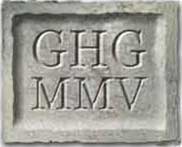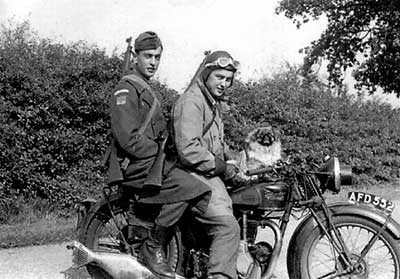
Guarlford History Group
Guarlford Detachment Home Guardby Keith ChesterWhen I joined the Home Guard in late 1941 my first duty, in my brand new Worcester Regimental uniform, was, as the newest recruit, to present the platoon's leaving present to our sergeant, Lord Beauchamp. He was going off to a war-time job at the War Office. We had regular Sunday morning parades at the Morgan works in Pickersleigh Road, next to Sir Alan Cobham's Flight Refuelling Company, an early pioneer in refuelling aircraft in flight. I'm blowed if I can remember much of what we did, except drill and unarmed combat. Night guard duties provided further excitement when we guarded Malvern from the top of the Link Church tower. Between solo star-gazing stints we could sleep on iron bedsteads, but there was a flourishing card school going all night. At dawn off they went sleepless for another long day on their farms. 
Transport for me was first provided by brother Paul on his motorbike until he joined the Royal Engineers (finishing up as an adjutant in the Madras Sappers & Miners in India), then in the back of Mr Webb's van as he passed from Portocks End Farm. He also carried a wonderful old-timer, Dick Gowan, from a cottage beside Wellings' forge at Little Heriots. He told me of his days driving a steamroller for the road menders, and when he had to walk to work at The Wyche. It must have made a long day. Sometimes we also collected Mr. (George?) Wall from Grove House Farm. Farmers and farmworkers came to day parades and exercises when they could be spared from their more important day jobs. We were nearly useful once. Paul and I were turned out at dead of night early in 1942 when an Me 110 crashed about where the Malvern Showground is now. By the time we got there the crew of two had been collected, so we went back to bed - with a few small souvenirs. We did not forget to take with us our shared rifle. No bullets of course - so much safer! Memories of exercisesa) Attacking The Wyche Cutting on a very dark night through back gardens. b) Alone at night in a wood near The Hollybush in a drizzle, entranced by a nearby nightingale. c) Sleeping in the open at the West Malvern rifle range, awaking in a fog and being marched to The Wyche where we surfaced above the fog in brilliant sunshine, with the hills and hillocks of Herefordshire poking through. What a night! d) An uncomfortable night trying to sleep directly on the concrete floor of a new part of a power station at Worcester. e) Being used in a camouflage demonstration and being pushed uncomfortably into a blackberry bush on the edge of Dripshill. f) Trying to nip unseen between gorse bushes on Link Common trailing a group of small boys who were intrigued by my high-tech equipment. It was my day for the intercom radio, and as it had a throat microphone I appeared to be talking to no one. Oh what a luvverly war! One more Dad's Army memory - we did get some shooting practice, with army rifles at the West Malvern range, and also with .22 rifles at an indoor range beneath the GPO at the top of Church street. Miscellaneous MemoriesThe pioneer aviator Sir Alan Cobham brought his rather primitive bi-planes to Malvern in about 1937 for 5/- flips. The temporary airfield was behind Mill Farm. Paul and I squeezed into the rear cockpit with two others and, no seatbelts, bounced off. Can't say I enjoyed it - scared stiff in fact. All that blue sky over one side and all that Malvern over the other. Happy in the RAF a few years later, with reassuring straps. I met Sir Alan several times in about 1942/3 when Malvern Council were requisitioning empty houses for his war workers at Flight Refuelling. Needless to say he had little time for bureaucracy. I have early memories of visiting Cherry Orchard in the late 20s; in particular I remember the family's white cockatoo in the living room, a rotating summerhouse beside the tennis court (very fashionable) and the measures taken to try to protect some of the cherry crop from the birds: strings of tin cans and anything that would clatter when pulled. Perhaps I was given the job? To help with food shortage rabbit breeding for meat was encouraged during the War and I kept up to about 30 in unused poultry houses. If you joined a Rabbit Club you could get rations of bran for them. Mrs. Martin of Bellars Lane was the local secretary, a very pleasant lady. To add to the story of basket making at Clevelode, much of the osier material must have come from Mr. Hayes' osier bed next to our house, The Homestead. I loved the resulting nesting lapwings and visiting snipe. I remember the ridge and furrow surface of the field opposite The Homestead. The ridges were about 10 ft across, mostly parallel to the road but at right angles at each end. The field was down to grass through the 20s and 30s when I knew it. It presumably had been an attempt to drain the heavy clay when cultivated many years before, and nothing to do with medieval strip farming. I've never seen a field like it elsewhere. Sending goods by rail was very different before the War. The GWR would collect plums in 12lb chips from us and New House Farm extraordinarily cheaply, even if we had only 2 or 3 dozen chips, and help with the loading. The fruit went to markets at Cardiff, Birmingham or Manchester for a few pence per pound. We could hardly have made a profit if pickers had to be paid, and certainly not if the rail transit had not been so cheap and accommodating. (If you have any other memories or photographs of the Home Guard or other volunteer services in World War Two, the Guarlford History Group would be very interested in them. Please contact a member of the group or e-mail the Webmaster). |